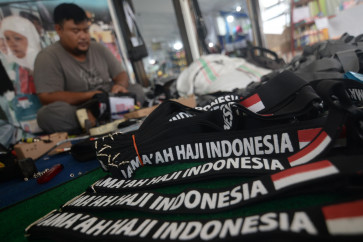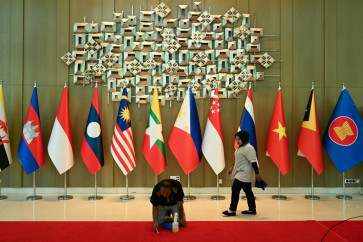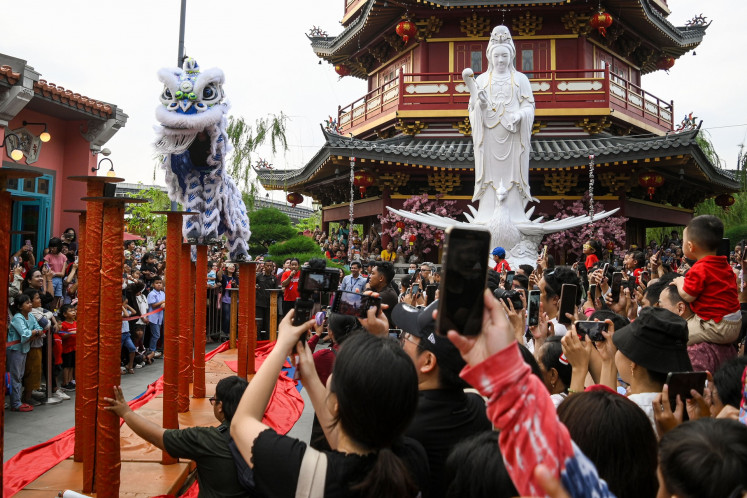Special team established to study Lapindo drilling in Sidoarjo
Worrisome flow: Mud spurts from a drilling site of PT PGE Lahendong, a subsidiary of state-owned oil and gas company Pertamina, in Tomohon, North Sulawesi
Change text size
Gift Premium Articles
to Anyone
 Worrisome flow: Mud spurts from a drilling site of PT PGE Lahendong, a subsidiary of state-owned oil and gas company Pertamina, in Tomohon, North Sulawesi. Residents fear that the mud flow, which started to gush two weeks ago, will worsen and engulf the area, as happened in Sidoarjo, East Java.(JP/Lita Aruperes) (JP/Lita Aruperes)
Worrisome flow: Mud spurts from a drilling site of PT PGE Lahendong, a subsidiary of state-owned oil and gas company Pertamina, in Tomohon, North Sulawesi. Residents fear that the mud flow, which started to gush two weeks ago, will worsen and engulf the area, as happened in Sidoarjo, East Java.(JP/Lita Aruperes) (JP/Lita Aruperes)
W
span class="caption">Worrisome flow: Mud spurts from a drilling site of PT PGE Lahendong, a subsidiary of state-owned oil and gas company Pertamina, in Tomohon, North Sulawesi. Residents fear that the mud flow, which started to gush two weeks ago, will worsen and engulf the area, as happened in Sidoarjo, East Java.(JP/Lita Aruperes)
Following the government's temporary suspension of a drill site operated by Lapindo Brantas Inc. in Sidoarjo regency, East Java, a special team has been set up by the governor of East Java to study the safety and feasibility of the company's activities, a move viewed as favorable to the company's interests.
Amien Widodo, the chairman of the newly formed team, told The Jakarta Post on Tuesday that the team had started their work and would finish it within three months.
'We are now collecting data from Lapindo Brantas and the Upstream Oil and Gas Regulatory Special Task Force (SKKMigas) on geological conditions and other matters related to the worthiness of gas-drilling in the area,' Amien said.
After this, he said, his team would conduct a survey with the help of geo-radar to make sure that the condition of the site in Tanggulangin district, Sidoarjo, was safe for gas exploration.
He said that theoretically, the drilling activity by Lapindo was lower in risk compared to exploratory activities at the blown-out oil well Banjar Panji-1. However, a 2010 research note conducted by the November 10 Institute of Technology (ITS) highlighted a crack within a radius of 2 kilometers from the mudflow site.
Amien said that if the crack reached a distance of 5 kilometers, or at the site of the exploratory drilling, then this would pose a danger.
He added that the team would report the results of its study to the governor of East Java. Whether there would be a cancellation of the drilling, he said, was not the team's authority.
Lapindo Brantas Inc., which is partly controlled by the family of businessman and Golkar Party chairman Aburizal Bakrie, previously claimed that its gas drilling activities had been approved by SKKMigas. It also said that the drilling was safe because it was conducted at a depth of less than a kilometer under the ground's surface, not like the drilling at the Banjar Panji-1 well, which reached a depth of over 3 kilometers.
Ali Masyhar, head of the Java chapter of SKK Migas, said that as a contractor or operator, Lapindo had fulfilled the requirements for the activity.
'All the licensing processes conducted from 2011 until October 2015 show that all the social aspects have been studied,' Ali said.
Separately, Ony Mahardika, the executive director of the Indonesian Forum for the Environment (Walhi) East Java, labeled the research team a mere trick to make people to accept the company's drilling plans.
'The government seems to protect corporations while neglecting people who are still traumatized by the mudflow disaster,' Ony said.
Meanwhile in Tomohon city, North Sulawesi, people have expressed fear that a spew of mud at the drilling area of PT Pertamina Geothermal Energy (PGE) Lahendong would end up like the mudflow disaster in Sidoarjo, East Java.
'We cannot sleep well. Mud is still spewing up,' Weddy Pongoh of Tondangouw subdistrict, South Tomohon district, Tomohon, said.
Geologist Pri Utami of Gadjah Mada University (UGM) Yogyakarta said that a provisional examination showed that it was not a spew of mud but rather of steam, which had brought soil with it to the surface and gave an appearance similar to that of mud.
Marly Gumalag, head of North Sulawesi Energy and Mineral Resources Agency (ESDM), concurred with Pri, saying that it was natural.
Dimas Wibisono, a spokesperson from PT PGE Lahendong, said that the steam coming out from the drilling site had already subsided. 'I want to make it clear that it was not mud but steam,' Dimas said.









